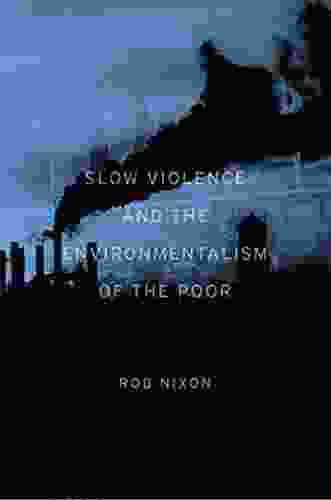Slow Violence and the Environmentalism of the Poor: Unveiling the Invisible Harms


In the realm of environmental discourse, the concept of "slow violence" has emerged as a powerful lens through which to examine the insidious and often overlooked environmental injustices that disproportionately impact marginalized communities. Rob Nixon, a renowned environmental humanities scholar, coined the term "slow violence" to describe the gradual, cumulative, and often invisible forms of environmental harm that occur over extended periods of time.
These harms, such as air and water pollution, climate change, and hazardous waste exposure, are often difficult to perceive and quantify, yet they have profound consequences for the health, livelihoods, and well-being of affected communities. As Nixon argues, slow violence is not merely a physical phenomenon; it is also a social and political issue that exposes the systemic inequalities that perpetuate environmental injustice.
4.7 out of 5
| Language | : | English |
| File size | : | 1326 KB |
| Text-to-Speech | : | Enabled |
| Screen Reader | : | Supported |
| Enhanced typesetting | : | Enabled |
| Word Wise | : | Enabled |
| Print length | : | 368 pages |
In his seminal work, "Slow Violence and the Environmentalism of the Poor," Nixon explores the experiences of communities around the world that are suffering from the devastating effects of slow violence. From toxic waste dumps in Nigeria to oil spills in the Niger Delta, Nixon paints a vivid and disturbing picture of the ways in which environmental pollution and degradation are disproportionately shouldered by the poor and marginalized.
The Environmentalism of the Poor
Nixon's work challenges the prevailing notion that environmentalism is solely the domain of affluent, white communities. He argues that the poor and marginalized are often the most ardent environmentalists, as their own survival and well-being are intimately tied to the health of their environment.
For example, in the Niger Delta, local communities have been fighting against oil companies for decades, demanding compensation for the environmental damage caused by oil spills and gas flaring. These communities have developed their own forms of environmental activism and advocacy, using traditional knowledge and local organizing to resist corporate polluters.
Nixon's concept of "the environmentalism of the poor" emphasizes the importance of recognizing and supporting the environmental struggles of marginalized communities. It challenges the idea that environmentalism is a luxury that only the wealthy can afford, and it highlights the need for inclusive and equitable approaches to environmental protection.
Invisible Harms, Unequal Impacts
One of the most striking aspects of slow violence is its invisibility. Unlike sudden and catastrophic environmental events, such as earthquakes or hurricanes, slow violence unfolds gradually and often below the threshold of public awareness. This invisibility allows environmental harms to persist and accumulate over time, with devastating consequences for affected communities.
For example, the long-term effects of air pollution on health are often difficult to detect and quantify. However, research has shown that exposure to air pollution can lead to a range of health problems, including respiratory illnesses, heart disease, and cancer. These health impacts are particularly severe in marginalized communities, which often live near industrial areas and have limited access to healthcare.
Similarly, the impacts of climate change are often felt most acutely by the poor and vulnerable. Coastal communities are at risk of flooding and sea-level rise, while farmers in drought-prone regions face crop failures and economic hardship. These climate-related impacts can devastate livelihoods and force people to abandon their homes and traditions.
Social and Political Causes
Slow violence is not simply a result of natural processes. It is also a product of social and political factors, such as poverty, inequality, and racism. Nixon argues that environmental injustice is often a byproduct of capitalism and colonialism, which have historically exploited and marginalized certain communities and regions.
For example, toxic waste dumps are often located in poor and minority communities because these communities have less power to resist corporate polluters. Similarly, climate change is largely driven by the unsustainable practices of wealthy countries, yet its impacts are felt most severely by the poor and marginalized in developing countries.
Resistance and Resilience
Despite the overwhelming challenges they face, marginalized communities are often at the forefront of environmental resistance. They have developed innovative strategies for organizing, advocacy, and direct action to protect their environment and their livelihoods.
In the United States, the environmental justice movement has played a vital role in raising awareness about environmental racism and advocating for policies to reduce pollution and protect vulnerable communities. In the global South, indigenous peoples are often the guardians of traditional environmental knowledge and practices, which offer sustainable alternatives to destructive industrial development.
The resilience of these communities in the face of adversity is a testament to the power of human agency and the importance of collective action. By fighting for environmental justice and protecting their communities, marginalized communities are not only safeguarding their own well-being but also contributing to a more just and sustainable future for all.
"Slow Violence and the Environmentalism of the Poor" is a groundbreaking work that offers a profound and nuanced understanding of the insidious and often invisible environmental injustices that plague marginalized communities. Nixon's work challenges us to rethink our assumptions about environmentalism, poverty, and inequality.
By bringing slow violence to light, Nixon exposes the systemic flaws that perpetuate environmental injustice. He calls for us to recognize and support the environmental struggles of the poor and to work towards creating a more just and sustainable world for all.
4.7 out of 5
| Language | : | English |
| File size | : | 1326 KB |
| Text-to-Speech | : | Enabled |
| Screen Reader | : | Supported |
| Enhanced typesetting | : | Enabled |
| Word Wise | : | Enabled |
| Print length | : | 368 pages |
Do you want to contribute by writing guest posts on this blog?
Please contact us and send us a resume of previous articles that you have written.
 Book
Book Novel
Novel Page
Page Chapter
Chapter Text
Text Story
Story Genre
Genre Reader
Reader Library
Library Paperback
Paperback E-book
E-book Magazine
Magazine Newspaper
Newspaper Paragraph
Paragraph Sentence
Sentence Bookmark
Bookmark Shelf
Shelf Glossary
Glossary Bibliography
Bibliography Foreword
Foreword Preface
Preface Synopsis
Synopsis Annotation
Annotation Footnote
Footnote Manuscript
Manuscript Scroll
Scroll Codex
Codex Tome
Tome Bestseller
Bestseller Classics
Classics Library card
Library card Narrative
Narrative Biography
Biography Autobiography
Autobiography Memoir
Memoir Reference
Reference Encyclopedia
Encyclopedia Reed Hatley
Reed Hatley Paul S Addison
Paul S Addison Reemus Bailey
Reemus Bailey Tom Palmer
Tom Palmer Peter Collar
Peter Collar R Cyril West
R Cyril West William De Rham
William De Rham Teresa W Haynes
Teresa W Haynes Professor Beaver
Professor Beaver Pearl Mason
Pearl Mason Peter Ball
Peter Ball Rick Adams
Rick Adams Ricardo Couto
Ricardo Couto Ray Morgan
Ray Morgan Samuel Poland
Samuel Poland Suzy Kline
Suzy Kline Roni Schotter
Roni Schotter Rachel A Koestler Grack
Rachel A Koestler Grack Steven Brawer
Steven Brawer Swapna Haddow
Swapna Haddow
Light bulbAdvertise smarter! Our strategic ad space ensures maximum exposure. Reserve your spot today!

 Jaime MitchellUnveiling "The Battle Begins: The Eli Diaries" - A Journey Into the Depths of...
Jaime MitchellUnveiling "The Battle Begins: The Eli Diaries" - A Journey Into the Depths of... Eddie BellFollow ·7.5k
Eddie BellFollow ·7.5k Steven HayesFollow ·5.5k
Steven HayesFollow ·5.5k Elliott CarterFollow ·18.6k
Elliott CarterFollow ·18.6k Hunter MitchellFollow ·15.5k
Hunter MitchellFollow ·15.5k Evan HayesFollow ·9.3k
Evan HayesFollow ·9.3k Bryan GrayFollow ·11.2k
Bryan GrayFollow ·11.2k Edmund HayesFollow ·10.7k
Edmund HayesFollow ·10.7k Chris ColemanFollow ·12.5k
Chris ColemanFollow ·12.5k

 Norman Butler
Norman ButlerUnveiling the Legacy of New England Salmon Hatcheries and...
Journey back in time to...

 J.R.R. Tolkien
J.R.R. TolkienEmbark on a Literary Adventure with Oliver Twist: A...
Unveiling the Complex World of Oliver...

 Todd Turner
Todd TurnerEnter the Mesmerizing Realm of Snooker: A Journey of...
Get ready to embark on an...

 Richard Wright
Richard WrightElements of Plasma Technology: A Journey into the...
Prologue:...

 George Bell
George BellBarbarian: Forgotten Legends of the Germanic Peoples - A...
Step into a world of...

 Drew Bell
Drew BellMaster GCSE English with the Ultimate Guide: Letts GCSE...
Prepare with Confidence for Success in GCSE...
4.7 out of 5
| Language | : | English |
| File size | : | 1326 KB |
| Text-to-Speech | : | Enabled |
| Screen Reader | : | Supported |
| Enhanced typesetting | : | Enabled |
| Word Wise | : | Enabled |
| Print length | : | 368 pages |










